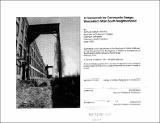| dc.contributor.advisor | Roy Strickland. | en_US |
| dc.contributor.author | DeSollar, Samuel Joseph | en_US |
| dc.coverage.spatial | n-us-ma | en_US |
| dc.date.accessioned | 2011-09-13T17:39:55Z | |
| dc.date.available | 2011-09-13T17:39:55Z | |
| dc.date.copyright | 1997 | en_US |
| dc.date.issued | 1997 | en_US |
| dc.identifier.uri | http://hdl.handle.net/1721.1/65702 | |
| dc.description | Thesis (M. Arch.)--Massachusetts Institute of Technology, Dept. of Architecture, 1997. | en_US |
| dc.description | Includes bibliographical references (leaves 109-110). | en_US |
| dc.description.abstract | Communities and the connections between them act as the foundation for the fabric of great cities. Suburbs were originally intended as a utopian alternative to crowded urban conditions. However, the current model of residential suburban development in the United States grows less affordable for many Americans, segregates private life to a realm exclusive of community and wastefully consumes material resources . While unchecked development diminishes the rural landscape, urban neighborhoods deteriorate, lacking the resources and amenities of new developments. The transformation of blighted urban neighborhoods into dense, mixed-use communities is a viable alternative to suburban sprawl. This thesis proposes to explore methods of configuring a community within an existing urban site: its streets, lots, and buildings; to conserve land and resources, make housing affordable for a wider range of incomes, and perpetuate a sense of individual identity and community vitality. The strategies explored will be developed into a series of guidelines or urban code for the site. Layout of streets, lots, buildings and open spaces will be determined for a small community. Guidelines will be established not only for housing within the project, but those services necessary to support a viable community: commercial centers, open space, and institutional facilities. These guidelines will allow development of the site at an architectural scale. | en_US |
| dc.description.statementofresponsibility | by Samuel Joseph DeSollar. | en_US |
| dc.format.extent | 110 leaves | en_US |
| dc.language.iso | eng | en_US |
| dc.publisher | Massachusetts Institute of Technology | en_US |
| dc.rights | M.I.T. theses are protected by
copyright. They may be viewed from this source for any purpose, but
reproduction or distribution in any format is prohibited without written
permission. See provided URL for inquiries about permission. | en_US |
| dc.rights.uri | http://dspace.mit.edu/handle/1721.1/7582 | en_US |
| dc.subject | Architecture | en_US |
| dc.title | A framework for community design : Worcester's Main South neighborhood | en_US |
| dc.type | Thesis | en_US |
| dc.description.degree | M.Arch. | en_US |
| dc.contributor.department | Massachusetts Institute of Technology. Department of Architecture | |
| dc.identifier.oclc | 36892262 | en_US |
